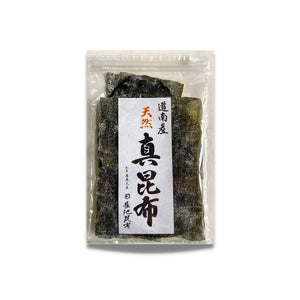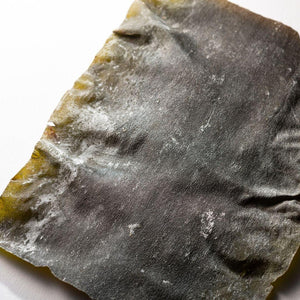

$21.50 USD
Worldwide delivery
[ALSO FEATURED IN OUR DASHI: "UMAMI" CARE PACKAGE]
Prefecture: Osaka
Producer: Nagaike Konbu
Ingredients: Ma-konbu ('true' natural kelp from Hokkaido)
Vegan, Gluten-free, Dairy-free, Soy-free
Size: 70g
Storage: Learn how to store in our blog post "Dashi: How to Store for Proper Freshness"
Dashi (stock/broth) is the essence of Japanese cuisine, creating umami and enhancing flavors of dishes. Konbu (kelp) is one of the key base dashi ingredients that creates a clean, clear dashi with a subtle, mellow flavor.
Ma-konbu ("true" kelp) is a high quality konbu with thick leaves that are wider than other konbu and a light brown color. It has a refined sweetness, deep aroma and rich umami flavor, and produces a clean, dark brown dashi with a hint of green coloring.
90% of Japan’skonbu (or kombu) is harvested in the northernmost prefecture of Hokkaido. Mineral-rich, ice cold water flowing down from Siberia provides a nutrient-dense environment for some of the world’s best konbu to grow. Each specific cultivation area produces a different tasting konbu based on the unique characteristics of the waters.
Tough and difficult to digest on its own, konbu must be cooked for a long time, which draws out its high amount of glutamic acid, an amino acid responsible forumami.
Nagaike Konbu's high-quality, native (not farm raised) ma-konbu has a refined flavor and deep aroma. The resulting dashi is clean and clear and is a great choice for vegetarians and vegans.
How to prepare: There is no need to remove the white powder from the konbu as it adds to the umami flavor. Cutting a few slits in the konbu also helps to release more flavor. There are two ways of brewing konbu dashi: cold and hot. Mizudashi (cold brew): Place 1-2 konbu strips in a large bottle of water in the refrigerator overnight.Nidashi (hot brew):Place 1-2 konbu strips in a pot of water over medium heat, skimming the surface to maintain a clear dashi. Remove from heat before the water comes to a boil to prevent the dashi from becoming bitter.
Suggested use: Clear soups, nabe, shabu shabu or oden hot pots, ohitashi (cooked vegetables), sushi rice, takikomi gohan (mixed rice), yudofu (boiled tofu), or seafood/fish dishes. The leftover konbu can be used to make konbu tsukudani using the recipe below.
Recipe:
Konbu Tsukudani (Simmered Kelp)
Shabu Shabu
Curry Udon
DISCLAIMER: We provide ingredients and common allergens based on the packaging as a reference only. Please consume with caution based on your own individual health concerns as we cannot guarantee the presence or lack of certain ingredients, allergens and/or animal products.
We use cookies on our website to give you the best shopping experience. By using this site, you agree to its use of cookies.